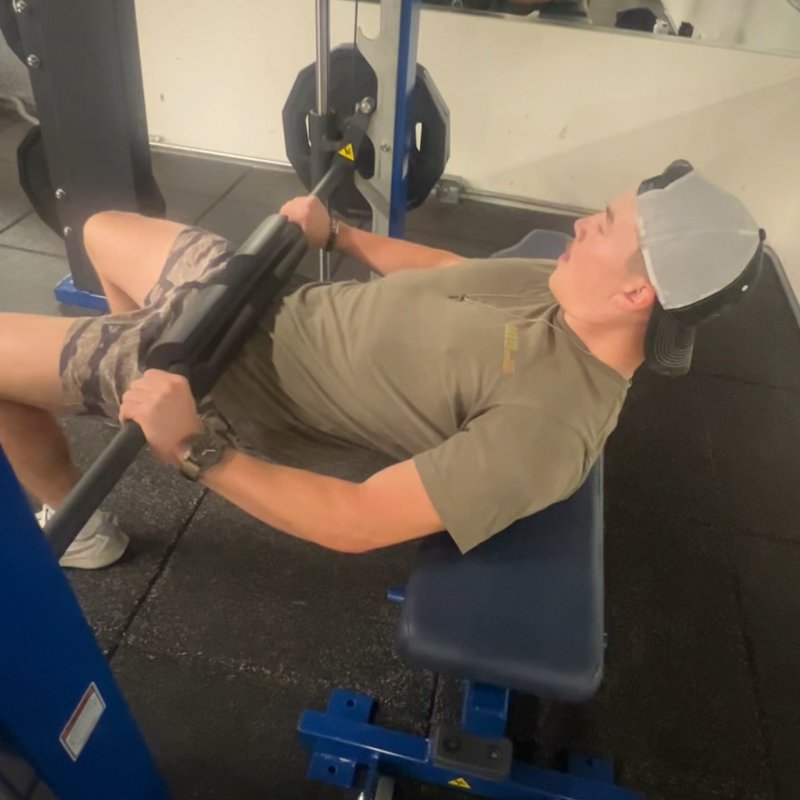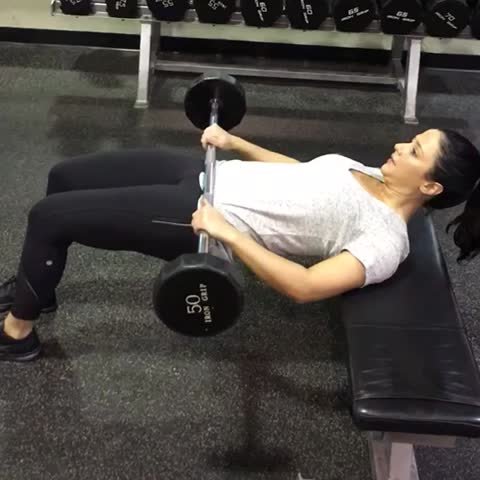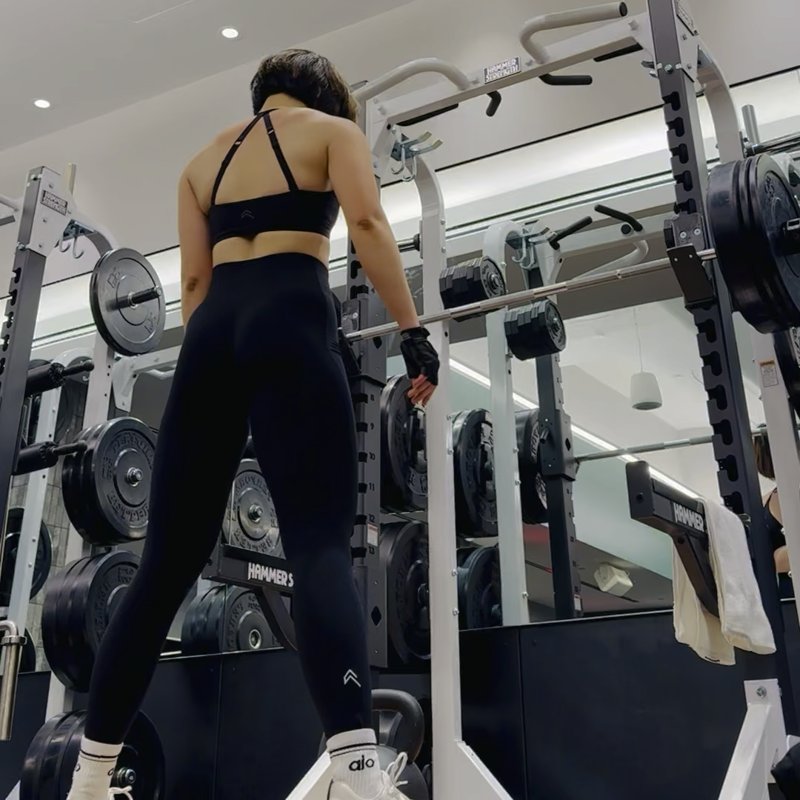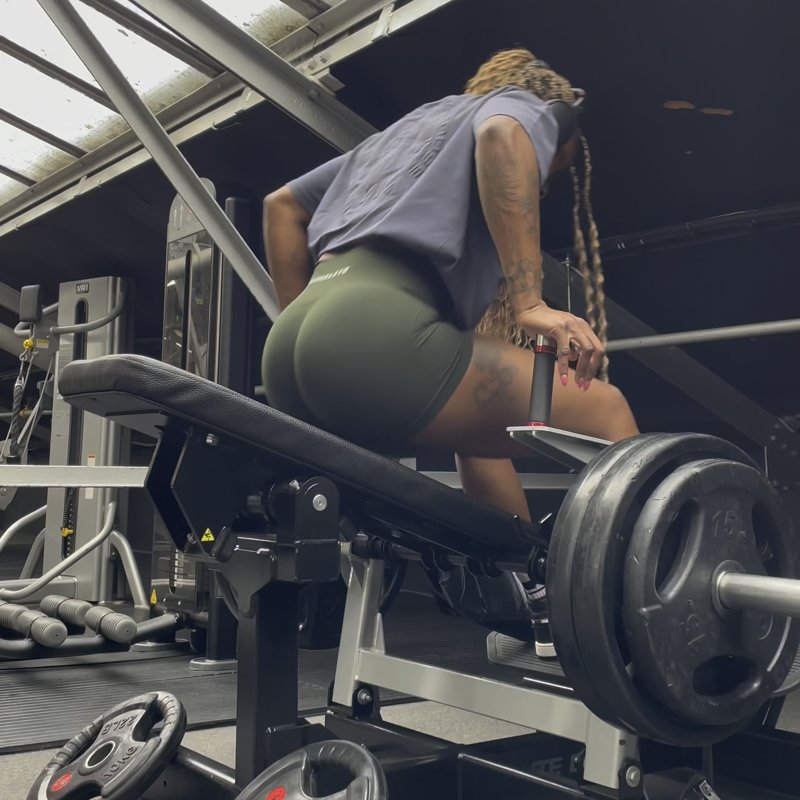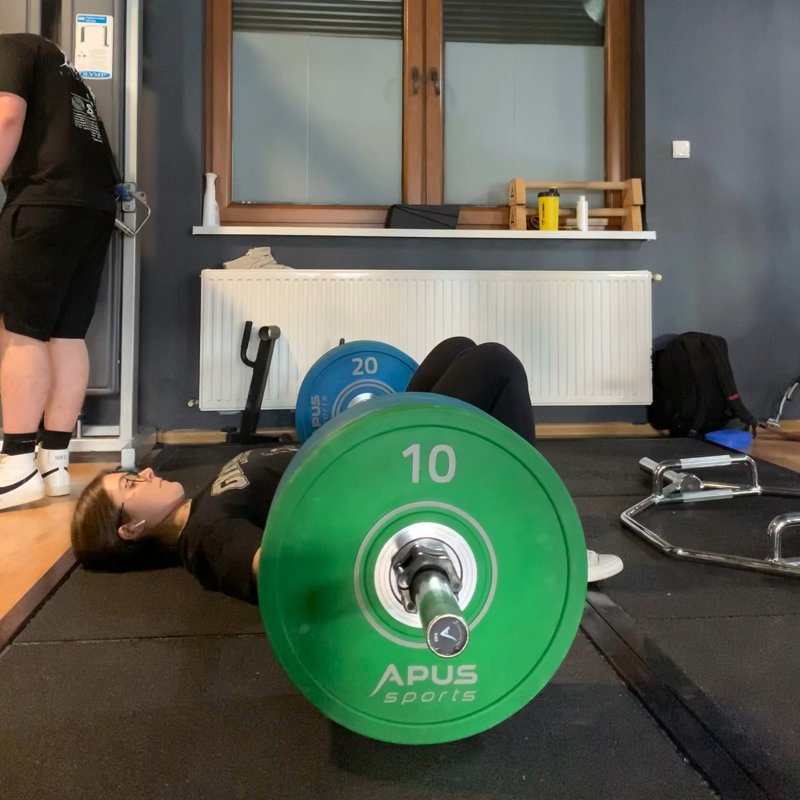Machine Hip Thrust: The Ultimate Guide
The Machine Hip Thrust is a lower body exercise performed on a specialized machine that targets the glutes through hip extension, providing a controlled environment for glute development with potential for substantial loading and consistent resistance patterns.
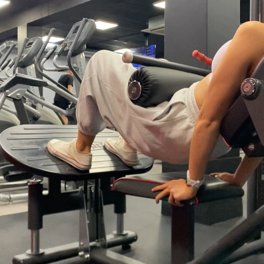
Quick Facts
Key Benefit
Targeted glute development with optimized mechanics
Primary Muscles
Glutes
Secondary Muscles
Abdominals, Erector Spinae, Hamstrings, Hip Adductors, Quadriceps
Equipment
machine
Difficulty
Beginner
Type
Strength
In This Guide
Ready to master the Machine Hip Thrust?
Track your progress, see improvements over time, and build strength consistently.
Download GravitusThe Machine Hip Thrust represents the evolution of one of the most effective exercises for glute development, offering the same biomechanical benefits as the barbell version with added convenience, safety, and potentially greater loading capacity. These specialized machines have gained popularity in gyms worldwide as the benefits of hip thrust exercises for both aesthetic and performance goals have become widely recognized.
What makes the machine variation particularly valuable is its guided movement path and supportive design. The fixed machine setup eliminates many of the setup challenges of barbell hip thrusts, creates consistent resistance patterns, and often provides padded contact points that enhance comfort during heavy loading. For many users, this means being able to focus exclusively on proper execution and muscle activation rather than stability concerns.
Beyond aesthetic benefits, the hip thrust movement pattern trains one of the most fundamental human movements—hip extension. This translates directly to improved performance in activities from sprinting and jumping to daily movements like climbing stairs or standing from a seated position. The posterior chain development from this exercise can also contribute to better posture and reduced lower back pain by strengthening the muscles that support proper pelvic alignment.
Whether your goal is to build stronger, more defined glutes, improve athletic performance, or enhance functional capacity for daily life, the Machine Hip Thrust provides an accessible and effective tool for developing one of the body's largest and most powerful muscle groups.
Benefits of Machine Hip Thrusts
The Machine Hip Thrust offers several unique advantages that make it a valuable addition to any lower body training program.
Simplified Setup
Eliminates the often awkward and time-consuming setup required for barbell hip thrusts, allowing more efficient workout sessions.
Guided Movement Path
The fixed machine design helps maintain proper form throughout the movement, potentially reducing the risk of technique errors.
Comfortable Loading
Specialized padding and contact points reduce discomfort during heavy loading compared to a barbell across the hips.
Progressive Overload Potential
Many hip thrust machines allow for substantial loading, enabling continued strength progression over time.
Consistent Resistance Profile
The machine's design often provides more consistent resistance throughout the range of motion compared to free weight variations.
Proper Form & Technique
Setup
- Adjust the machine settings to fit your body proportions, including seat height and back pad position.
- Sit on the machine with your back firmly against the back pad and feet positioned on the platform shoulder-width apart.
- Position your hips directly under the thigh pad or roller that will rest across your hip crease.
- Place your feet so that at the top of the movement, your shins will be vertical or slightly angled.
- Grasp the machine's handles for stability if available, otherwise position your arms comfortably at your sides.
- Ensure your spine is in a neutral position with your chin slightly tucked rather than extended.
- Brace your core lightly to maintain pelvic stability throughout the movement.
- If the machine has a safety mechanism, ensure it's disengaged before beginning the movement.
Movement
- Push through your heels to drive your hips upward, extending until your body forms a straight line from shoulders to knees.
- Focus on contracting your glutes to power the movement rather than pushing primarily with your legs.
- At the top position, your torso and thighs should form approximately a 90-degree angle.
- Squeeze your glutes intensely at the top position for a momentary isometric contraction.
- Maintain a neutral spine throughout—avoid excessive arching of the lower back at the top position.
- Lower the weight with control back toward the starting position, maintaining tension in the glutes.
- Allow your hips to descend until they're just above the bottom position without fully resting or losing tension.
- Immediately begin the next repetition, maintaining control and glute engagement throughout the set.
Key Form Tips
Foot Pressure
Drive primarily through your heels rather than your toes to maximize posterior chain engagement and minimize quad involvement.
Glute Focus
Concentrate on feeling your glutes contract and stretch throughout the movement—they should be the primary muscles working.
Hip Position
At the top of the movement, your body should form a straight line from shoulders to knees without hyperextending your lower back.
Full Extension
Ensure you reach complete hip extension at the top of each repetition, fully squeezing the glutes at the peak contraction.
Controlled Tempo
Avoid using momentum, particularly on the ascent—each repetition should be deliberate and controlled to maximize muscle tension.
Muscles Worked
Primary Muscles
- glutes: The gluteal muscle group, including the gluteus maximus (the largest and primary mover), gluteus medius, and gluteus minimus, which collectively work to extend the hip, provide lateral stability, and stabilize the pelvis during the thrust movement.
Secondary Muscles
- hamstrings: Assist in hip extension during the movement, particularly the biceps femoris, semitendinosus, and semimembranosus.
- erector spinae: Activate isometrically to maintain spinal position and proper posture throughout the exercise.
- hip adductors: Provide stability and assist in maintaining proper leg position during the movement.
- quadriceps: Engage primarily as stabilizers rather than prime movers, particularly the rectus femoris which crosses the hip joint.
- abdominals: Work isometrically to maintain pelvic position and prevent excessive arching of the lower back.
Common Mistakes and How to Fix Them
Lower Back Arching
Excessively arching the lower back at the top of the movement, shifting stress from the glutes to the lumbar spine. Focus on a posterior pelvic tilt at the top position by squeezing your glutes and slightly tucking your pelvis. Think about shortening the distance between your ribs and pelvis rather than pushing your hips as high as possible. Practice with lighter weight until you can consistently maintain proper spinal position. Consider using a mirror from the side or having a training partner check your positioning until proper form becomes habitual.
Insufficient Hip Extension
Not reaching full extension at the top of the movement, limiting glute activation and results. Ensure your hips rise to a position where your torso and thighs form roughly a 90-degree angle at the peak of the movement. Focus on creating a straight line from shoulders to knees at the top position. If using lighter weight doesn't allow you to feel or achieve full extension, try implementing brief isometric holds at the top position to enhance awareness of proper positioning. Consider temporarily placing a hand on your glutes during practice sets to physically feel the muscle contraction at full extension.
Quad Dominance
Driving primarily through the front of the foot, shifting emphasis to the quadriceps rather than the glutes. Concentrate on pushing primarily through your heels rather than your toes. Try slightly elevating your toes by placing the ball of your foot on a small weight plate or wedge to enforce heel drive. Focus on the mind-muscle connection with your glutes, mentally emphasizing them as the prime movers rather than your legs pushing. If persistent, consider adjusting foot position slightly further away from your body to change the leverage in favor of glute activation.
Rushing Repetitions
Performing repetitions too quickly with momentum rather than controlled muscle contraction, reducing effectiveness. Implement a specific tempo prescription, such as 2 seconds up, 1 second squeeze at the top, 2 seconds down. Consider counting during each phase to ensure appropriate timing. Focus on feeling each portion of the movement rather than simply completing repetitions. If necessary, reduce the weight until you can maintain full control throughout the entire set. Experiment with paused repetitions (3-5 second hold at the top) to eliminate momentum and reinforce proper control.
Incomplete Range of Motion
Not descending far enough on each repetition, limiting the stretch and activation of the glutes through a full range. Lower your hips until you feel a complete stretch in the glutes without fully resting at the bottom position. Ensure the machine allows for appropriate range of motion based on your individual mobility and proportions. If the machine design restricts proper range, consider supplementing with free weight variations that allow complete motion. Gradually work to increase your comfortable range over time as mobility and strength improve, never forcing positions that cause discomfort.
Machine Hip Thrust Variations
Equipment Variations
-

Lever Hip Thrust Machine
Uses a plate-loaded lever system that creates a fixed arc of movement, often with adjustable settings for varying body sizes.
-
Smith Machine Hip Thrust
A hybrid approach using a Smith machine for guided movement combined with a bench to support the upper back.
-
Cable Hip Thrust
Performed using a cable machine with an ankle attachment, creating constant tension throughout the range of motion.
-

Belt Squat Machine Hip Thrust
Utilizing a belt squat machine with the weight loaded from below, creating a unique resistance profile.
Technical Variations
-

Single-Leg Machine Hip Thrust
Performing the movement with one leg at a time to address strength imbalances and increase the challenge on each side.
-
Tempo Machine Hip Thrust
Manipulating the speed of different phases (e.g., 3 seconds up, 2 seconds hold, 3 seconds down) to increase time under tension.
-

Pulse Machine Hip Thrust
Using small, pulsing movements at the top of the range of motion to increase time under tension and muscle fatigue.
-

Isometric Machine Hip Thrust
Holding the contracted position for an extended period (10-30 seconds) to build endurance and static strength in the glutes.
Frequently Asked Questions
Both variations can be highly effective, with each offering distinct advantages that might make one preferable depending on individual factors and circumstances.
The machine hip thrust provides several benefits: The fixed position and guided motion often help maintain proper form throughout the movement. Setup is typically much faster and more convenient, allowing for more efficient workouts. Many find the padded contact points more comfortable than a barbell across the hips, especially with heavier loads. The stable nature of the machine often allows users to focus more intently on glute activation without stabilization concerns. Some machine designs provide a more consistent resistance curve throughout the movement.
The barbell hip thrust maintains its own advantages: More widely available in most gyms compared to specialized hip thrust machines. Typically allows for greater freedom of movement and individualization of position. Engages more stabilizer muscles due to the free weight nature of the exercise. May better transfer to athletic activities due to the less restricted movement pattern. Usually permits easier loading modifications through small plate additions.
For practical application, consider these guidelines: If both options are available, try both to determine which allows you to feel greater glute activation and comfortable loading. If you struggle with setup or form on barbell hip thrusts, the machine variation might help you focus more effectively on the target muscles. For competition-specific training or athletic transfer, the barbell version might offer better carryover due to its less restricted nature. For optimizing hypertrophy with minimal joint stress, the machine version often proves advantageous.
The bottom line is that the most effective version is the one you'll perform consistently with proper form and progressive loading. Many successful trainees incorporate both variations in their program to benefit from the unique advantages of each.
The appropriate weight for machine hip thrusts depends on your training experience, current strength level, and specific goals. The glutes are potentially the largest and strongest muscles in the human body, capable of handling substantial loading with proper progression.
As a general guideline, select a weight that allows you to complete your target repetitions with proper form while still finding the last few reps challenging. For most beginners, this means starting relatively light to master the movement pattern before progressing to more substantial loads. Intermediate lifters might work with moderate weights that challenge them in the 10-15 repetition range. Advanced lifters often benefit from heavier loading in the 6-10 repetition range for strength development, while still incorporating higher-rep work for metabolic stress and endurance.
The key indicators that your weight selection is appropriate include: You can maintain proper spinal alignment throughout the movement without excessive arching. You feel the work primarily in your glutes rather than your lower back or hamstrings. You can achieve full hip extension at the top of each repetition. You maintain control throughout the entire range of motion without momentum or jerky movements.
For optimal development, consider implementing periodized training with phases that emphasize different loading patterns: Higher-rep phases (15-20 reps) with moderate weight for metabolic stress and endurance. Moderate-rep phases (10-12 reps) with challenging weight for hypertrophy emphasis. Lower-rep phases (6-8 reps) with heavier weight for strength development.
Remember that progressive overload remains essential for continued development, but this can come through various factors beyond simply adding weight - including increased repetitions, sets, decreased rest periods, or enhanced execution quality. Rather than chasing numbers on the weight stack, focus on the quality of glute contraction and systematic progression based on your individual response.
You should primarily feel machine hip thrusts working in your gluteus maximus (the largest and most superficial glute muscle), with potentially some secondary sensation in your gluteus medius, gluteus minimus, and hamstrings depending on your specific execution and individual biomechanics.
When performed correctly, you should experience: A distinct contraction and "squeeze" sensation in the glute muscles at the top of the movement. A stretch feeling in the glutes at the bottom of the movement. Minimal sensation in the lower back, which should remain neutral throughout. Some activation in the hamstrings is normal, but they should not dominate the movement.
If you're not feeling the exercise primarily in your glutes, consider these adjustments: Focus on pushing primarily through your heels rather than the balls of your feet, which shifts emphasis to the posterior chain. Ensure you're reaching full hip extension at the top of each repetition, consciously squeezing your glutes at peak contraction. Try slightly different foot positions - moving feet slightly farther from your body often increases glute engagement relative to quadriceps. Implement a brief pause at the top of each repetition to enhance mind-muscle connection. Consider performing glute activation exercises like banded side steps or clamshells before hip thrusts to "wake up" the gluteal muscles.
Individual factors like limb length, hip structure, and muscle fiber distribution can influence exactly how the exercise feels for you. Some variation in sensation between individuals is normal, but the primary work should always be felt in the gluteal region rather than the lower back or predominantly in the legs.
If you consistently have difficulty feeling your glutes working during hip thrusts despite trying various adjustments, consider consulting with a qualified trainer who can observe your execution and provide personalized feedback.
The optimal frequency for machine hip thrusts depends on your overall training program structure, recovery capacity, and specific goals. That said, here are evidence-based guidelines to help determine an appropriate frequency:
For general fitness and moderate glute development, training hip thrusts 2 times per week typically provides sufficient stimulus while allowing adequate recovery between sessions. This might be implemented within a full-body or upper/lower split routine. For prioritized glute development, increasing frequency to 3 times weekly can accelerate progress, particularly if you vary the intensity or rep ranges across different sessions. For example, one heavy day (6-8 reps), one moderate day (10-12 reps), and one higher-rep day (15-20 reps).
Several factors should influence your individual frequency: Your recovery capacity - if you're experiencing persistent soreness that doesn't resolve before the next training session, you might need to reduce frequency temporarily. Your overall training volume - consider the total work your glutes receive from all exercises, not just hip thrusts. Your experience level - beginners often benefit from moderate frequency (2x/week) with emphasis on technique development, while advanced lifters might utilize higher frequency with more nuanced loading strategies.
The glutes, like all muscle groups, require both sufficient stimulus for growth and adequate recovery time. Finding the right balance is key to optimal progress. Pay attention to performance indicators - if your strength or performance on hip thrusts is declining across sessions, you might need more recovery time or reduced volume per session.
Regardless of frequency, ensure progressive overload by systematically increasing challenge through weight, repetitions, sets, or execution quality. Many successful programs implement periodized approaches where hip thrust frequency and intensity vary across different training phases to prevent plateaus and overuse issues.
Video Demonstrations

Log in to watch video demonstrations
Login to Watch3 video demonstrations available
Find more video demonstrations in the Gravitus app
Tips from the Community
-

Third set to burnout, squeeze glutes at top and breathe out/engage core and TA!
Track your progress with Gravitus
Download Gravitus to log your workouts, track your progress, and join a community of fitness enthusiasts.

Helpful Resources
One Rep Max Calculator
Find your one rep max for any exercise without maximal testing. Essential for developing effective strength training programs.
Calculate 1RMWorkout Programs
Follow structured workout programs created by fitness professionals to maximize your strength and muscle gains.
View Programs